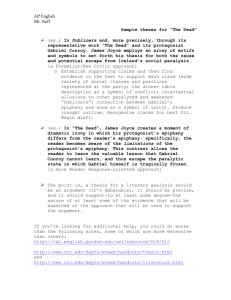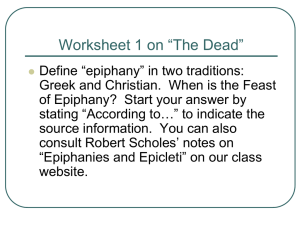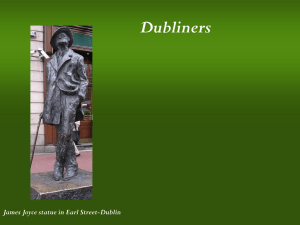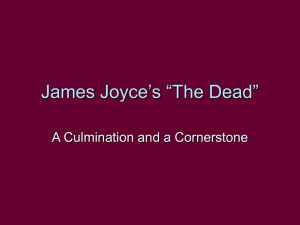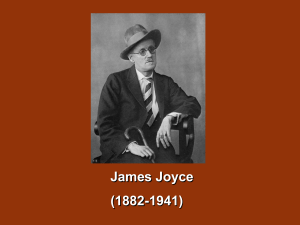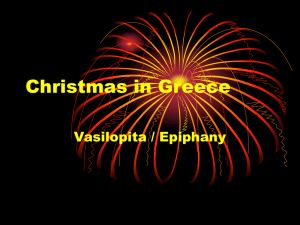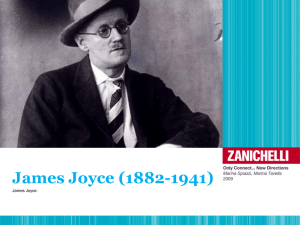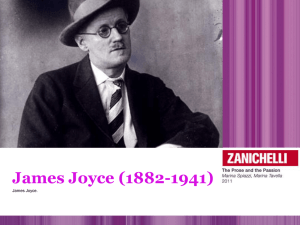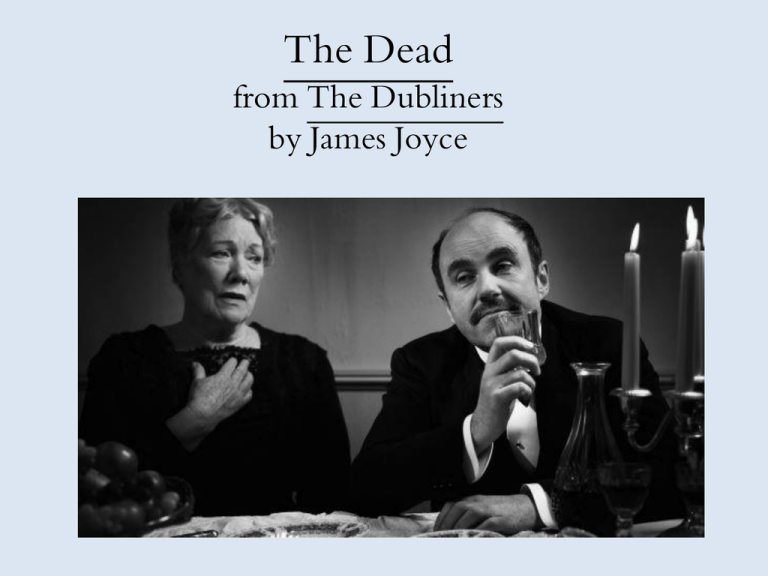
The Dead
from The Dubliners
by James Joyce
The Dubliners (1914)
•
•
•
•
•
•
•
Collection of novels / collection of epiphanies
Portrait of the Dubliners (The dubliners/the dead) human behaviour
Portait of a spiritual paralysis the death of the soul
The dubliners are slaves of their family, moral, cultural, religious, and political life.
Paralysis is conveyd by the absence of events and the slow narrative rhythm
J. Joyce is more intrested in a characters’ inner than external reality
Moral environment of Dublin: religiosity mixed with materialism
( examples: simony in The Sisters and the commercial metaphore used by Fatehr Purdon
in Grace)
Novel’s structure
paralysis epiphany escape failure (percieved by the character or not) frustration
•
The structure conveys an idea of inactivity and stagnation
Thematic sections
•
•
•
•
1 section (childhood)
2 section (adolescence)
3 section (maturity)
4 section (public life)
•
The Sisters, An Encounter, Araby
Eveline, After the Race, Two Gallants, The Boarding House
A Little Cloud, Counterparts, Clay, A Painful Case
Ivy day in the Commitee Room, A Mother, Grace
Function of The Dead: Epilogue
Le fil rouge (themes):
•
•
•
•
•
•
•
•
•
Epiphany
Death and connection between the living and the dead (The Sisters, The Dead)
Religion
Opressive and useless morality
Fake friendship
Snow and windows
Love
The fall
Paralysis, gnomon, simony
circular motion
•
The collection could be a portrait of Dublin (which becomes a character) and a
great all one epiphany
•
The first story begins with a boy looking at a bright window, thinking about death
and later you can read ‘’I felt my soul receding pleseant and vicious place’’ (The
Sisters)
The last story ends with Gabriel who stands behind the window, looking at the
snow and thinking about death: ‘’His soul had approached that region where dwell
the vast hosts of the dead.’’ (The Dead)
•
Epiphany
•
From greek epiphaneia "manifestation, striking appearance’’
•
The word ‘’epiphany’’ belongs to the religious code and originally referred to insight through
the divine
•
For epiphany J. Joyce intends a sudden spiritual manifestation by which a character has a
silent moment of full awareness and the feeling of a community with the reality surrounding
him.
•
An epiphany guides a deeper insight into the truth of things.
•
J. Joyce uses the narrative technique of the epiphany to show through appereance and
details the essence of something and the awakeness of consciousness
•
The word refers to the moment in a narrative when events, images, ideas, or any
combination of theirs may produce an explosive recognition of meaning both for character
and reader
Epiphany
•
An epiphany can be explicit, such as in Two Gallants :
‘’ Corley halted at the first lamp and stared grimly before him. Then with a grave
gesture he extended a hand towards the light and, smiling, opened it slowly to the
gaze of his disciple. A small gold coin shone in the palm.’’
•
An epiphany can be a mood, such as it happens in Araby :
‘’ Gazing up into the darkness I saw myself as a creature driven and derided by vanity;
and my eyes burned with anguish and anger’’
•
An epiphany can be mysterious and conveyed by gestures, such as visible in The Sisters:
‘’ And what do you ink but there he was, sitting up by himself in the dark in his confession-box,
wide- awake and laughing-like softly to himself?"
Gnomon and simony
•
The stories are gnomons of paralysis and simony
•
The Sisters : ‘’ Every night as I gazed up at the window I said softly to myself the word paralysis. It had
always sounded strangely in my ears, like the word gnomon in the Euclid and the word simony in the
Catechism. But now it sounded to me like the name of some maleficent and sinful being.’’
•
Gnomon is an ancient Greek word meaning "indicator", "one who discerns," or "that which reveals.’’
- for Joyce is an aesthetic process, whereby there is some absence, removal, or avoidance in each story.
- the substance is percieved by the appereance
•
Simony
- act of paying for sacraments and consequently for holy offices or for positions in the hierarchy of a
church (named after Simon Magus)
- forms of trafficking for money in ‘’spiritual things’’
- spiritual values are commercially exploited (spiritual and religious crisis)
•
‘’Paralysis’’ in association with ‘’gnomon’’ suggests that the incompleteness of the stories will paralyze
the interpretative activity of the reader.
Narrative tecnique
•
•
•
•
3rd person invisible narrator he shows a character’s mind
Point of view: multiple perspective (the main character’s)
The narrator use the tecnique of SHOWING
The narrator seems absent : ‘’ L’artista, come il Dio della creazione,
rimane…invisibile, sottilizzato fino a svanire, indifferente, intento a limarsi le
unghie ‘’ (Dedalus, J. Joyce, cap V)
Characterization
•
•
•
•
•
•
Synthetic narrative tecnique overlap of realistic details
The meticulouse details have often a symbolic meaning
The character is shown with particular attention to his phrases and gestures
Language used by the character
Physical aspect
Behaviour
Style
• The narrative style changes depending on the character:
- childish and exclamative in Clay
- banal and full of cliches in A Little Cloud
- complex and rich in images in A painful Case
•
•
The form an argument is expressed is important as the argument itself
Joyce’s prose fits to their characters the passive state of mind are expressed with passive
form
Symbolic realism
•
•
•
•
‘’It is not my fault that the odour of ashpits and old weeds and offal hangs round my stories. I
seriously believe that you will retard the course of civilisation in Ireland by preventing the
Irish people from having one good look at themselves in my nicely polished looking glass.’’
(Letter to G.Richards, 23 June 1906)
The function of the artist is to SHOW reality (it implies the use of symbols) and not to teach
The reader have to find meaning with his own perception (the narrator is impersonal)
Details have a deeper meaning
The dead
•
•
•
sequences
1) The arrival of the guests
2) The Dinner
3) Gabriel and Gretta at the hotel
•
setting
Enclosed space (Aunt’s house, buggy, hotel’s room) character’s interiority
Characters
•
•
•
•
•
•
•
•
•
Kate and Julia Morkan --- sisters
Mary Jane Morkan --- sister Morkan’s niece
Gabriel and Gretta Conroy --- main character and his wife
Lily --- maid
Michael Fury
Molly Ivors --- patriotic collegue of Gabriel’s
Freddy Malins --- drunkard, a fried of Gabriel’s
Mr. Browne --- guest
Bartell D’Arcy --- famous tenor
Gabriel
•
•
•
•
•
•
•
He’s an intellectual
He lives situations of failure and frustration
He’s very proud of him self and his education and considers the other lower
He can’t relate with Lily he gave her money and escapes instead of to apologizing
He can’t relate with Molly Ivors
He’s very anxious about his speech
He can’t relate with his wife he wants to posses her
Gabriel and Gretta
•
•
•
•
•
•
•
Gabriel’s epiphany starts while he contemplates Gretta
Contemplation
Object of desire
Artistic object
Gretta doesn’t belong to reality anymore
Their love fails
Gabriel is sexually frustrated
Gabriel’s epiphany
•
Gabriel’s epiphany’s about: 1) the death of the soul 2) Dead and living are connected 3)
His identity is less real than Michel Fury’s
•
Jelousy, anger, compassion
•
Gabriel feels sorry for himself
- ‘’While he had been full of memories of their secret life together, full of tenderness and
joy and desire, she had been comparing him with another’’
- “So she had had that romance in her life: a man had died for her sake. It hardly
pained him now to think how poor a part he, her husband, had played in her life”
- “His soul swooned slowly as he heard the snow falling faintly through the universe
and faintly falling, like the descent of their last end, upon all the living and the dead”
•
Time setting: day of epiphany
Eros and Thanatos
•
•
•
-
Fall in death and fall in love
Michel Fury fell in love with Gretta and died for her :
(‘’I think he died for me’’)
The search for love leads to:
frustrated love wich refuges in death ( A painful case)
love beaten by death ( The dead)
↓
death of the soul
•
The lonlieness of the soul leads to death
•
Sense of frustration and inability
•
The dubliners’s paralysis leads to a failure of theri
relationships
The Symbol of Snow
•
•
•
•
•
•
Falls over the soul of the living and the dead
The dubliners are beingless beings ‘’snow’’ falls over their souls death of the soul
Death and peace
‘’the snow is general all over Irland’’
Propleptic function – echo
Coldness paralysis
•
‘’It had begun to snow again’’, ‘’snow was general all over Ireland’’, ‘’ His soul swooned
slowly as he heard the snow falling faintly through the universe’’
Religiuos Code
•
•
•
•
Gabriel the angel of annunciation / the hope of rebirth
Michel (Fury) The avanging angel / remorse
Time setting: the day of Epiphany
The dinner reminds the Eucharist

